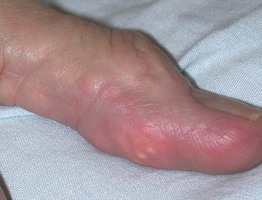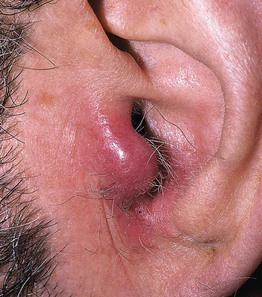40
Deposition Disorders
A heterogeneous group of disorders in which there are deposits, usually of endogenous materials, within the skin. Entities belonging to this group that are covered in other chapters include mucinoses (Chapter 38), amyloidosis (Chapter 39), porphyrias (Chapter 41), and calcinosis cutis (Chapter 42).
Gout
• Tophi present as firm skin-colored to white or yellow papules and nodules, usually around joints and on the helices of the ears (Fig. 40.1); in general, they appear ~10 years after the initial episode of acute arthritis and occur in ~10% of patients with gout.

Fig. 40.1 Tophaceous gout of a digit. The deposits create a multilobulated appearance. A small incision over the yellow-white areas followed by microscopic examination of the expressed material would allow a bedside diagnosis.
• Tophi can become inflamed (Fig. 40.2), and they may or may not resolve following normalization of serum uric acid levels.










